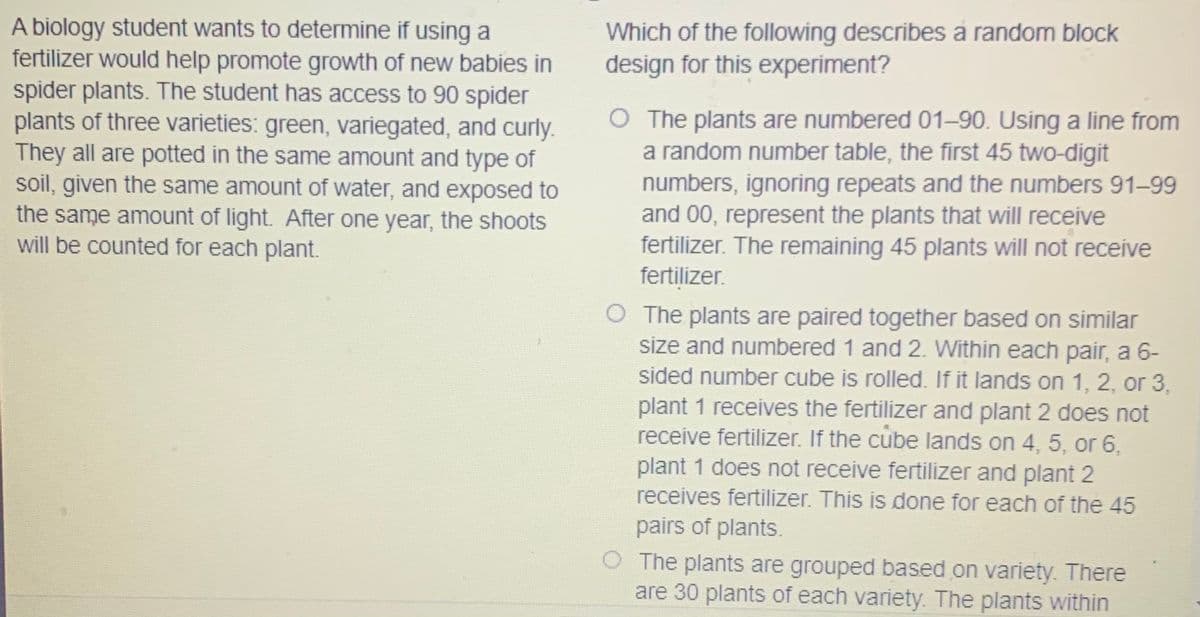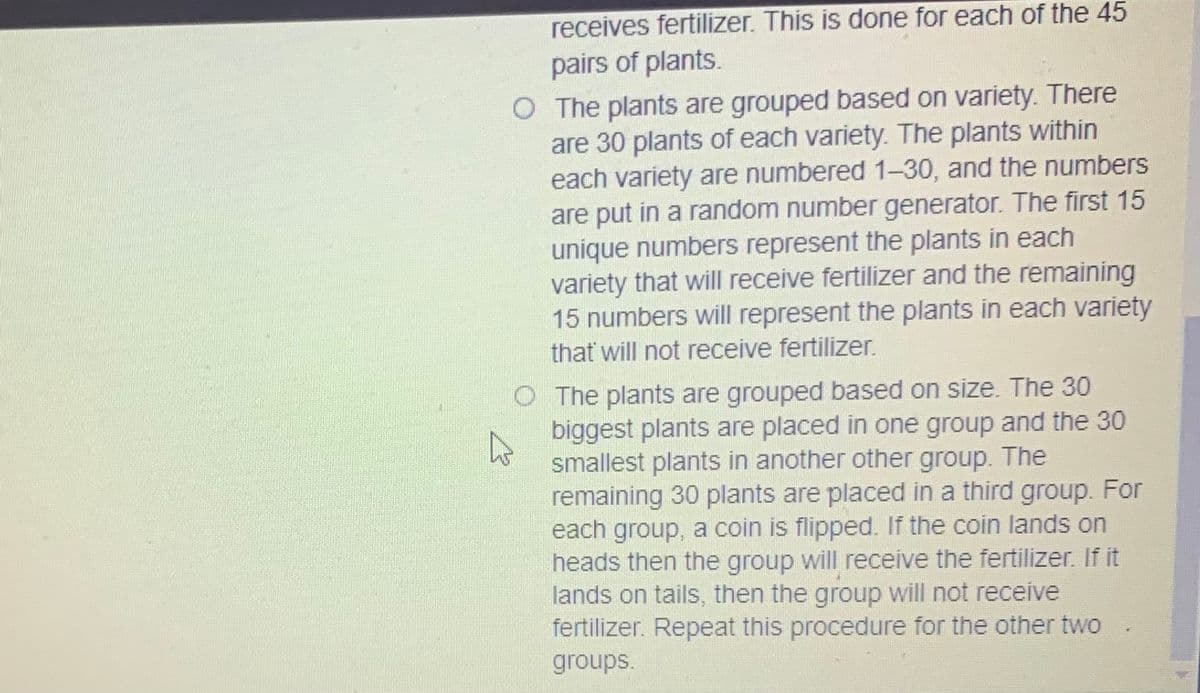A biology student wants to determine if using a fertilizer would help promote growth of new babies in spider plants. The student has access to 90 spider plants of three varieties: green, variegated, and curly. They all are potted in the same amount and type of soil, given the same amount of water, and exposed to the same amount of light. After one year, the shoots will be counted for each plant. Which of the following describes a random block design for this experiment? O The plants are numbered 01-90. Using a line from a random number table, the first 45 two-digit numbers, ignoring repeats and the numbers 91-99 and 00, represent the plants that will receive fertilizer. The remaining 45 plants will not receive fertilizer. O The plants are paired together based on similar size and numbered 1 and 2. Within each pair, a 6- sided number cube is rolled. If it lands on 1, 2, or 3, plant 1 receives the fertilizer and plant 2 does not receive fertilizer. If the cube lands on 4, 5, or 6, plant 1 does not receive fertilizer and plant 2 receives fertilizer. This is done for each of the 45 pairs of plants. O The plants are grouped based on variety. There are 30 nlants
A biology student wants to determine if using a fertilizer would help promote growth of new babies in spider plants. The student has access to 90 spider plants of three varieties: green, variegated, and curly. They all are potted in the same amount and type of soil, given the same amount of water, and exposed to the same amount of light. After one year, the shoots will be counted for each plant. Which of the following describes a random block design for this experiment? O The plants are numbered 01-90. Using a line from a random number table, the first 45 two-digit numbers, ignoring repeats and the numbers 91-99 and 00, represent the plants that will receive fertilizer. The remaining 45 plants will not receive fertilizer. O The plants are paired together based on similar size and numbered 1 and 2. Within each pair, a 6- sided number cube is rolled. If it lands on 1, 2, or 3, plant 1 receives the fertilizer and plant 2 does not receive fertilizer. If the cube lands on 4, 5, or 6, plant 1 does not receive fertilizer and plant 2 receives fertilizer. This is done for each of the 45 pairs of plants. O The plants are grouped based on variety. There are 30 nlants
Holt Mcdougal Larson Pre-algebra: Student Edition 2012
1st Edition
ISBN:9780547587776
Author:HOLT MCDOUGAL
Publisher:HOLT MCDOUGAL
Chapter11: Data Analysis And Probability
Section11.8: Probabilities Of Disjoint And Overlapping Events
Problem 2C
Related questions
Question

Transcribed Image Text:A biology student wants to determine if using a
fertilizer would help promote growth of new babies in
spider plants. The student has access to 90 spider
plants of three varieties: green, variegated, and curly.
They all are potted in the same amount and type of
soil, given the same amount of water, and exposed to
the same amount of light. After one year, the shoots
will be counted for each plant.
Which of the following describes a random block
design for this experiment?
The plants are numbered 01-90. Using a line from
a random number table, the first 45 two-digit
numbers, ignoring repeats and the numbers 91-99
and 00, represent the plants that will receive
fertilizer. The remaining 45 plants will not receive
fertilizer.
O The plants are paired together based on similar
size and numbered 1 and 2. Within each pair, a 6-
sided number cube is rolled. If it lands on 1, 2, or 3,
plant 1 receives the fertilizer and plant 2 does not
receive fertilizer. If the cube lands on 4, 5, or 6,
plant 1 does not receive fertilizer and plant 2
receives fertilizer. This is done for each of the 45
pairs of plants.
O The plants are grouped based on variety. There
are 30 plants of each variety. The plants within

Transcribed Image Text:receives fertilizer. This is done for each of the 45
pairs of plants.
O The plants are grouped based on variety. There
are 30 plants of each variety. The plants within
each variety are numbered 1-30, and the numbers
are put in a random number generator. The first 15
unique numbers represent the plants in each
variety that will receive fertilizer and the remaining
15 numbers will represent the plants in each variety
that will not receive fertilizer.
O The plants are grouped based on size. The 30
biggest plants are placed in one group and the 30
smallest plants in another other group. The
remaining 30 plants are placed in a third group. For
each group, a coin is flipped. If the coin lands on
heads then the group will receive the fertilizer. If it
lands on tails, then the group will not receive
fertilizer. Repeat this procedure for the other two
groups.
Expert Solution
This question has been solved!
Explore an expertly crafted, step-by-step solution for a thorough understanding of key concepts.
This is a popular solution!
Trending now
This is a popular solution!
Step by step
Solved in 3 steps

Knowledge Booster
Learn more about
Need a deep-dive on the concept behind this application? Look no further. Learn more about this topic, advanced-math and related others by exploring similar questions and additional content below.Recommended textbooks for you

Holt Mcdougal Larson Pre-algebra: Student Edition…
Algebra
ISBN:
9780547587776
Author:
HOLT MCDOUGAL
Publisher:
HOLT MCDOUGAL

Algebra & Trigonometry with Analytic Geometry
Algebra
ISBN:
9781133382119
Author:
Swokowski
Publisher:
Cengage

Glencoe Algebra 1, Student Edition, 9780079039897…
Algebra
ISBN:
9780079039897
Author:
Carter
Publisher:
McGraw Hill

Holt Mcdougal Larson Pre-algebra: Student Edition…
Algebra
ISBN:
9780547587776
Author:
HOLT MCDOUGAL
Publisher:
HOLT MCDOUGAL

Algebra & Trigonometry with Analytic Geometry
Algebra
ISBN:
9781133382119
Author:
Swokowski
Publisher:
Cengage

Glencoe Algebra 1, Student Edition, 9780079039897…
Algebra
ISBN:
9780079039897
Author:
Carter
Publisher:
McGraw Hill

College Algebra (MindTap Course List)
Algebra
ISBN:
9781305652231
Author:
R. David Gustafson, Jeff Hughes
Publisher:
Cengage Learning
